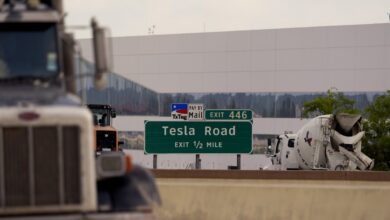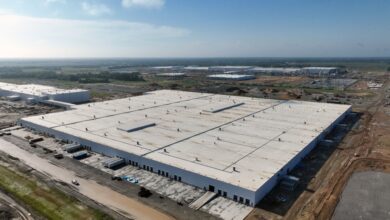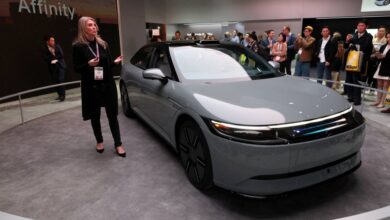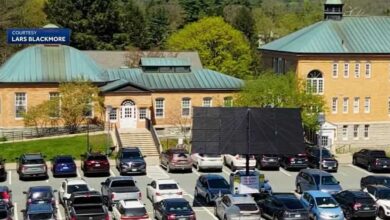The future of lithium and electric vehicles in Imperial County
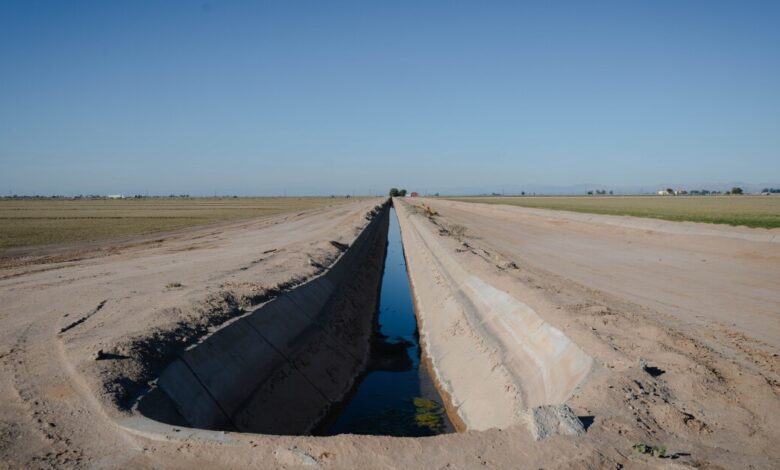
S1: Welcome in San Diego , it’s Jade Hyndman. Lithium extraction could mean big business in Imperial Valley. Only if money exchanges hands among people who actually live there. We’ll talk about the challenges. This is KPBS Midday Edition. Connecting our communities through conversation. Across the Imperial Valley , people are preparing for the arrival of the lithium industry. The renewable energy sector is making big promises of new jobs and transformational growth. But that’s a story that many longtime residents have heard before. In a new two part series , KPBS reporter Corey Suzuki digs into what this could all mean for Imperial County , a place where efforts to build an economy around renewable energy previously failed. So how might lithium be different ? That’s where part two of the series picks up. Take a listen.
S2: The town of Carla. Patricia is a small working class farming community on the north end of Imperial County. One Main Street , $1 store surrounded by acres of fields. It’s a sleepy place , but there’s a chance that could all change in the coming years.
S3: We see this as one of the greatest economic opportunities of our lifetime.
S2: That’s California Governor Gavin Newsom. He was in town last year to hold a press conference in front of a new lithium plant under construction , just a few miles west of Cala Patria. Recent studies have found that the Imperial Valley is home to huge amounts of lithium , a key element in electric car batteries and other technology , and demand is soaring around the world as countries like the US fight to get gas powered cars off the road and slow climate change. Newsom and other officials say the industry could transform California and other local communities with new jobs and tax dollars.
S3: Where 100 cents of the dollar. We want to go back to the community 80% specifically to the community and economic development opportunities , and then 20% to the Salton Sea. That’s never happened before. So that’s the commitment.
S2: It was a big deal. At the same time , though , some Imperial County residents wonder how seriously to take those claims. Officials have made big claims about renewable energies in the past , like geothermal and solar. Michael Llewellyn serves on Calipari’s city council.
S4: I’m excited. I’m optimistic. But there are still those thoughts.
S2: For one , the momentum around it is strong. Right now , three energy companies are planning extraction plants at the north end of the county , and the state has thrown its full weight behind those projects. If the companies hire local residents for jobs in those plants. That’s one of the most direct ways the region will benefit.
S5: It’s sort of the easiest for regulators , for local elected officials to be able to do something about it , to enforce it.
S2: Crystal Koloff is the associate director of the Government Finance Research Center at the University of Illinois , Chicago.
S5: They can easily say , let’s make sure that , um , labor is local if there are needs to upskill the labor if they don’t have the skills necessary. Let’s do an economic development initiatives to try to get them the skills that are needed.
S2: Another way communities could benefit is through the statewide lithium extraction tax , a law that was passed in 2022. That tax requires all lithium producers in California to pay out between 400 and $800 into a statewide fund for each ton of lithium they pull out of the ground , 80% of which goes back to the counties where that lithium came from. In Imperial County , officials would be required to set aside almost a third of those tax dollars for a number of frontline communities , including Cleopatra. A portion of money from the state wide fund would also go towards restoring the toxic Salton Sea. Llewellyn says these benefits would go a long way towards things like the town’s crumbling sewage system and its parks and schools.
S4: I can’t speak for Brawley. I can’t speak for El Centro or Imperial , but every city has these issues that need to be addressed ASAP , and I believe that the lithium will help us with that.
S2: Still , experts warn that those benefits are not a sure thing yet.
S6: None of the companies are , uh , developing that lithium extraction yet.
S2: Chris Benner is a professor of environmental studies in sociology at UC Santa Cruz. He says it’s important to remember that no one has actually started pulling lithium out of the ground at industrial levels.
S6: I mean , they have plans , right ? And they broke ground in January on their new geothermal plant that will have then lithium extraction connected to it. Um , but they’re still trying to get all the financial investment they need to build out that full plant.
S2: The lithium companies with plans and Imperial County also haven’t signed any binding commitments to offer well-paid jobs or focus on hiring local residents. That lithium extraction tax , too , is also in jeopardy. In November , a California ballot measure that’s targeting many state taxes could wipe it out , forcing lawmakers and local communities to start from scratch. Also , in the longer term , most of the jobs will come after the lithium is extracted when factories turn the mineral into batteries and electric cars. That could be a big opportunity for Imperial County , but it’s also a big open question.
S6: So less than one half of 1% of all jobs in the full supply chain are in lithium extraction. So , you know , if we want to keep our eyes on the ball like that biggest ball is in the electric vehicle and battery manufacturing , not so much in extraction.
S2: Back in colour. Patricia Llewellyn says he understands that those questions are significant. Still , he’s hopeful about everything that’s happened so far.
S4: I think this is this will be the time that everything is done right , not just for a patriot or an island or for the entire county.
S2: But Llewellyn also feels the weight of this moment for the region. Kali Patria , he says , can’t afford another broken promise.
S1: You just heard from KPBS reporter Corey Suzuki. He joins me now to talk more about the future of Lithium and Imperial Valley. Corey , welcome back to midday.
S2: Hi , Jade. Thanks for having me.
S1: So glad you’re here. So as we just heard , lithium is a really big deal for Imperial County. You’ve been reporting on it for a few months.
S2: I have a friend who’s a photojournalist and covers environmental justice issues a lot , and he had mentioned that this was a big shift happening Imperial County. So it was something that I’d I’d heard about. But as I started doing more work in Imperial County this spring , it just really stood out to me how much lithium would be coming up in conversations about all of these different things. I would be talking to , like a spokesperson at Iid , the power utility , or a high school band teacher or a district superintendent. Um , kind of across these different stories that I was working on that weren’t necessarily directly related to lithium , but it would still keep coming up. It would it would be something that people were thinking about or were having their eye on in terms of kind of like their long term planning and something as something that was reshaping sort of how people were thinking about the future. And so lithium and this past renewable past history of renewable energy , I think we’re just things that that sort of really felt like they were they were very present in the minds of people who I was getting a chance to talk to. Yeah.
S1: Yeah. And like you said , you’ve also reported on the history of renewable energy in the region and that includes geothermal and solar , but neither really took off , at least in the way people expected them to.
S2: And I think to understand kind of what has happened in the past , why there’s sort of this feeling that these booms had made promises and then did not deliver. I think you have to kind of take each one at a time. Geothermal was sort of the first big energy boom to take off renewable energy boom to take off. It started around the 1980s , and there were some big predictions that , uh , you know , that that government agencies that the federal Department of Energy was making about the amount of power that could be that could be produced in the Imperial Valley , the amount of , um , the amount of , uh , geothermal resources that were in the valley. And geothermal has a lot of potential for strong jobs because it takes these , these plants that take a lot of workers to , to keep running. And so in geothermal case , what happened was it was really sort of industry wide challenges that began to emerge. There was sort of the economics of building up these plants that are incredibly expensive to get off the ground , a lot of upfront costs. And then there were also some technological issues at the time. It was hard for geothermal companies , harder for geothermal companies to , um , sort of place the plants accurately and be able to drill into the ground and to get into sort of the hot , salty water deep , deep underground that geothermal energy comes from , and to be able to accurately sort of set up their plants so that they were being able to tap into that. And then there were also sort of , uh , challenges with infrastructure at the time to being able to get in place the kind of , um , really strong , um , massive power lines that that are needed to pull that kind of energy away from these plants. Um , and so all of that sort of led to , um , just that geothermal as an industry never really took off in the way that , um , in the way that it was promising. And then with solar , I think it was sort of a different story because , um , in that case , there was , again , a lot of excitement. Um , it started taking off kind of in the , um , in the , the early 20 tens. But in that case , I think what happened was it seems like the industry , uh , and maybe local officials sort of overpromised a little bit on kind of what jobs would be involved in solar specifically. Solar technology involves a lot of construction work at the front end and , um , a lot of temporary jobs , but then those jobs quickly taper off. And then , uh , in the long term , solar , uh , mostly relies on just a much smaller number of workers to actually maintain those plants. Uh , so that was sort of that was sort of what happened then also in , in the Imperial Valley specifically , solar ended up competing , I think , in the eyes of many people with , um , with agriculture in a way that , uh , a lot of people felt was not beneficial to the many workers that the agricultural industry supports in the Imperial Valley and many people , including a. And I spoke to you. I ended up feeling like that , that that in that case , solar actually maybe even ended up taking away more jobs than it was creating. Mhm.
S1: Mhm. Well , I mean , given that history still there is so much momentum around lithium. So what makes it different.
S2: Well I think the , the big things that make lithium different are um , for one the circumstances that are surrounding it. I mean , I think , um , the stakes around lithium in many ways are greater than ever. Climate change is accelerating the climate crisis and sort of the the impacts of it , the extreme weather that we’re seeing around the world is making the need for things like electric cars and other battery technology just more and more extreme. Um , those technologies will enable more gas powered cars to get off the road , will enable more use of renewable energy infrastructure. Battery large batteries are becoming more and more common in in different parts of um of the country and different energy grids that allow renewable technologies like solar and like wind to sort of soak up energy and put it into these batteries for use later. That push for electric vehicles is getting a lot of weight from the state. The state has really thrown its weight behind the amount of of interest in in lithium in Imperial County. And there’s also Imperial County is home to a lot of lithium. That’s that’s one of the other big things is that there is a really , really significant amount of lithium that is deep underneath the Salton Sea in these sort of same pockets of hot , salty water that these geothermal plants have been tapping into for decades now. So that makes the Imperial Valley in some ways , it seems like at this point , well positioned to sort of meet these these growing needs for this mineral around the world. And in terms of jobs , specifically in sort of the benefits that this technology and this industry could bring to communities in the Imperial Valley. There are also some things that are different about this time , specifically in terms of the jobs and the other sort of efforts that are in place to make sure that residents benefit. Um , the kind of lithium extraction that’s planned in the Imperial Valley relies more on the same technology as geothermal. So they would offer kind of in many ways , the same sort of longer term jobs that geothermal had offered before , except if , um , if the predictions pan out about lithium except at a , at a larger scale. So there’s sort of a lot of , a lot of moving parts here , a lot that’s up in the air right now in terms of , um , seeing how it pans out , because lithium extraction hasn’t actually begun at an industrial scale. But there are also sort of these different things that that experts say could make lithium different than past renewable energy booms. Yeah.
S1: Yeah. So sounds like there’s a lot of hope there. Um , in this.
S2: At the same time , I think it is also very clear that many people feel like past renewable energy developments , have taken advantage of the valley and have sort of taken advantage of the , um , the many resources , the kind of large amounts of sunlight and wind in some cases , and also geothermal energy that the Imperial Valley has and , and feel like the people who live in the Imperial Valley have sort of been , um , overlooked in that rush to , to get access to some of those renewable energy resources. And so I think that there is this from from everyone that I talked to , there was this sort of those two sides of that feeling , both optimism and also kind of a sense , uh , that this was something that had had happened in the past. And I worry that that , um , same pattern might repeat itself again. But I think that , you know , what also stood out to me is that there’s just , you know , there’s there’s so much happening in the Imperial Valley and , um , yes , lithium is is going to be a large , a really large conversation , I’m sure. Of course , that could transform the valley in some ways. But I think overall too , you know , there is a lot of excitement also because this is kind of bringing up a lot of different conversations in the Imperial Valley about , um , the way things are and the way , um , the way that cities and county governments are managed. And about what , uh , what people want to see done differently. And so I think that either way , however , lithium continues to. To reshape things in the region. I think that it seems clear to me that this the conversations that are coming out of this are , are not going anywhere.
S1: I’ve been speaking with KPBS Imperial Valley reporter Corey Suzuki. You can follow his reporting and more on KPBS. Org Corey. Thank you very much.
S2: Thank you so much , Jade.
S1: Coming up , while there’s plenty of lithium in Imperial County , the infrastructure for lithium battery cars is lacking.
S7: Everybody has to be able to make this transition. At least the state contends if the state is going to reduce the emissions it wants to see drop.
S1: We’ll connect the dots when we return. You’re listening to KPBS Midday Edition. Welcome back. You’re listening to KPBS Midday Edition. I’m Jade Hindman , as you just heard , the Imperial Valley is seeing a boom in lithium. If mined successfully , it could really boost the manufacturing of electric vehicle batteries. However , there aren’t many Imperial Valley residents who own an EV. In fact , electric car ownership in Imperial County is much lower compared to the rest of the state. And for those who do own an EV , it’s difficult to find a place to charge them. I’m here with Calmatters climate reporter Alejandro Lazo. He’s here to talk about the lack of EV chargers in the region and what it could mean for California. Alejandro , welcome. Hi.
S7: Hi. Thanks very much for having me.
S1: Glad to have you here.
S7: Uh , some folks obviously charge from home , but there are only four fast charging public stations available in a region that spans something like 4500mi². Wow.
S1: Wow.
S7: Uh , one of the most obvious and important reasons is people just don’t own a lot of electric cars. Uh , so you’re presented with a bit of a chicken and an egg situation. These , uh , chargers are installed by private companies , and if they don’t have a customer base , they’re not likely to install chargers there. You have places like the Bay area , Los Angeles , coastal regions where a lot of people charge at home. So you have a lot of people who own electric cars , uh , who are , uh , come from higher earning , uh , households. And so you have a big customer base. And so you’ve seen more chargers go places like that.
S1: As far as the chargers are concerned.
S7: I mean , uh , both the Biden administration and the state of California have a variety of different , uh , programs dedicated to trying to build up this infrastructure. They see it as really important for , uh , California to meet its zero emissions goals to reduce the state’s carbon footprint is particularly from the transportation sector , which is the biggest emitter of greenhouse gas emissions , which cause climate change. But , uh , there are some folks , uh , as I sort of detailed in this story I wrote recently , uh , who are trying to take matters in their own hands , uh , there is a , uh , environmental justice nonprofit , El Civic del Valle , which is based in Imperial County. There are farmworker , uh , founded , public health oriented , uh , environmental justice organization. And the leader of that group , uh , Luis Olmedo , uh , has been making a push to build , uh , electric charger , uh , infrastructure project , uh , that the that the nonprofit itself will run and maintain. And I found that really interesting. They’re using some state grants or they’re applying for some state grants. Uh , but they’re also getting a lot of , of the money for the Chargers through donations.
S1: And you just mentioned local activists who are hoping to bring more chargers to the region.
S7: They have they they launched this initiative a couple of years ago. They built their first , uh , charger at their headquarters in the city of Brawley. And it’s a level what’s known as a level two charger , which charges up , uh , an electric car , uh , from anywhere between 4 to 8 hours. And it’s they’re available for anybody , I guess , who has that amount of time , uh , maybe drives their vehicle for a visit or is in the area and can keep their car parked there at their headquarters for for that long or get a lower charge. Um , and more recently , just opened up a series of fast chargers , which means you can charge a car anywhere from , uh , 20 minutes to 1 hour in a public park in the city of Calexico , which is the the border town there , right across from Mexicali and Imperial County. And they’re trying to build more. They , they , they see , uh , the need for public charging infrastructure in the Imperial County as necessary to improve electric vehicle adoption , EV adoption , and therefore. Reduce some of the , uh , you know , really bad air pollution that , uh , you know , proliferates there in Imperial County. It’s a part of the state that has some of the worst air pollution in the state , and therefore some of the worst air pollution in the country. And they just really see it as a as an issue of equity , as an issue of justice , as you mentioned. They say it’s only right that the residents of this region benefit from that as well. And in order to do so , they need electric cars. They need the infrastructure to maintain those electric cars. Mhm.
S8: Mhm. Well I mean this.
S1: Has become a political issue. So what makes it so contentious. You’d think it would be prioritizing uh , one thing over the other would be simple but it’s not. Yeah.
S7: Yeah. It’s interesting. Well , the politics are , um , it can be contentious in the city of Calexico , there’s been a or there was a recall campaign , a successful recall campaign. And , uh , the issue to , to recall to , uh , members of the city council there in April , there was a whole host of issues at play in that election , but one of them did become these electric chargers that were placed in the park there in Calexico , the leader of the of the recall campaign spoke to , uh , the Imperial Irrigation District in January. So that’s earlier this year just contending that , um , putting these chargers there was a distraction that they took parkland away from , from the city. Uh , yeah. So it just it’s interesting. I think there are a lot of bigger issues at play , but the electric chargers got caught up in the politics of the region. And I should mention , uh , we did reach out to , uh , Marisa Hurtado , uh , the mayor and the coordinator of that campaign , but she declined to speak to us.
S1: Well , and like you mentioned , electric car ownership is low in the Imperial Valley.
S7: And I think for all the reasons that chargers proliferate or , excuse me , electric cars proliferate in a place like , uh , the San Francisco Bay area or the Los Angeles or San Diego region is part of the reason why , uh , there are fewer in , uh , a place like , uh , Imperial Valley , a very rural place where there are vast distances where people are perhaps concerned about , uh , you know , traversing these long distances and being far away from , uh , a charger and running out of battery. And this is also a place where a lot of people live in apartments , and so they don’t have home charging the county’s median household income is much lower than the rest of the state. And so it’s essentially a the type of place that the state is really trying to get more infrastructure in. But perhaps it just doesn’t come as naturally as more dense kind of urban , higher income areas in the state where you’ve seen a lot more electric car adoption. Yeah.
S8: Yeah.
S1:
S7: Uh , it wants to ensure that , um , sales are widespread across the state. The state is mandating that 35% of statewide sales of 2026 models. So just right around the corner , be zero emission and then ramping that up to 68% in 2030. And then all new car sales , uh , be zero emissions in 2035. So if you’re , uh , requiring everybody to be buying electric cars when , when they buy a new car by a certain date and they have no place to charge , it’ll be a problem. And also keep in mind that , uh , California does really want to carry out these ambitious climate goals , uh , equitably. They want to make sure that it’s not just the highest earners , the wealthiest people in the state who can participate. Everybody has to be able to make this transition. At least the state contends , if the state is going to reduce the emissions it wants to see , drop by the dates , it sort of set out for itself.
S1:
S7: Uh , it’s right on the border with Mexico , and in Mexicali is a much , much larger city than , uh , these smaller cities that are right across the border. Uh , it is. A very vast place driving around. There’s just , you know , fields and fields of agriculture and then open desert and just how kind of remote and unique it is. All of those things sort of stood out. And I think by going there , I did really get an appreciation of just how difficult it would be to own electric car if you didn’t have a place to charge up. I think one might be legitimately concerned about running out of , uh , running out of running out of energy in their car. Hmm.
S1: Hmm.
S7: The group that I profiled in this story , uh , again , they want to have a network of 40 chargers. They have , uh , they say they’re moving ahead , putting more electric chargers in different parts of , of the valley. And yet this is a priority for the state of California as well. Uh , they certainly will have been emphasizing getting this kind of infrastructure in these kinds of places sooner rather than later.
S8: I’ve been speaking.
S1: With Calmatters climate reporter Alejandro Lasso. Alejandro , thank you so much.
S7: Thanks again for having me.
S1: That’s our show for today. I’m your host , Jade Hindman. Thanks for tuning in to Midday Edition. Be sure to have a great day on purpose , everyone.
